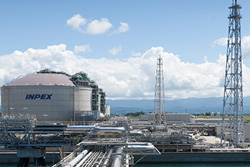Japan Imports Less LNG in 2016
Japan imported 83.34mn metric tons of LNG in 2016, according to provisional trade data published January 25 by the finance ministry in Tokyo.
That represented a volume decline of just 2% compared to 2015. The value decreased by two-fifths (40.4%) to 3,283.9 billion yen ($28.9bn)
LNG accounted for 5% of all Japan’s total 2016 import value of 65,965.1bn yen.
In December 2016, Japan imported 7.55mn mt which was 6.5% less year on year, and the value fell by a quarter to 323.4bn yen ($2.85bn).

Inpex opened its Naoetsu LNG import terminal in 2013 at Joetsu City in Niigata Prefecture (Photo credit: Inpex)
Japanese importers will be hoping to continue controlling LNG import costs by increasing US imports in 2017. Although the US Energy Information Administration said recently it expects natural gas prices to rise this year and next, relative to 2016 levels, US LNG remains still cost-competitive against most of Japan’s existing long-term contractual supplies.
Japan’s ministry of economy, trade and industry (Meti) reported two weeks ago that the average spot LNG import price contracted in December 2016 was $8/mn Btu, while the average price of spot cargoes arriving that month (and therefore priced in previous months) was $6.80/mn Btu.
Meti said the corresponding prices for November 2016 were $7 and $5.90/mn Btu respectively.
Japanese LNG imports peaked in 2014, as the country used more gas to replace nuclear power generation. LNG imports have gradually declined since.
US industry association Nuclear Energy Institute (NEI) said two weeks ago that, of Japan’s 42 commercially operable reactors, only Kyushu Electric's Sendai 1 and 2 and Shikoku Electric’s Ikata 3 are normally in commercial operation. The rest remain shut for extended testing and re-permitting, following the devastating tsunami in March 11 2011 that flooded some reactors on Japan's northeast coast and killed more than 15,000 people.
Sendai 1 plant in southern Japan’s Kagoshima prefecture began restart operations December 8 after a scheduled maintenance and refuelling outage that began in October 2016. However Sendai 2 began an outage December 16 that is expected to last until late February.
Mark Smedley





